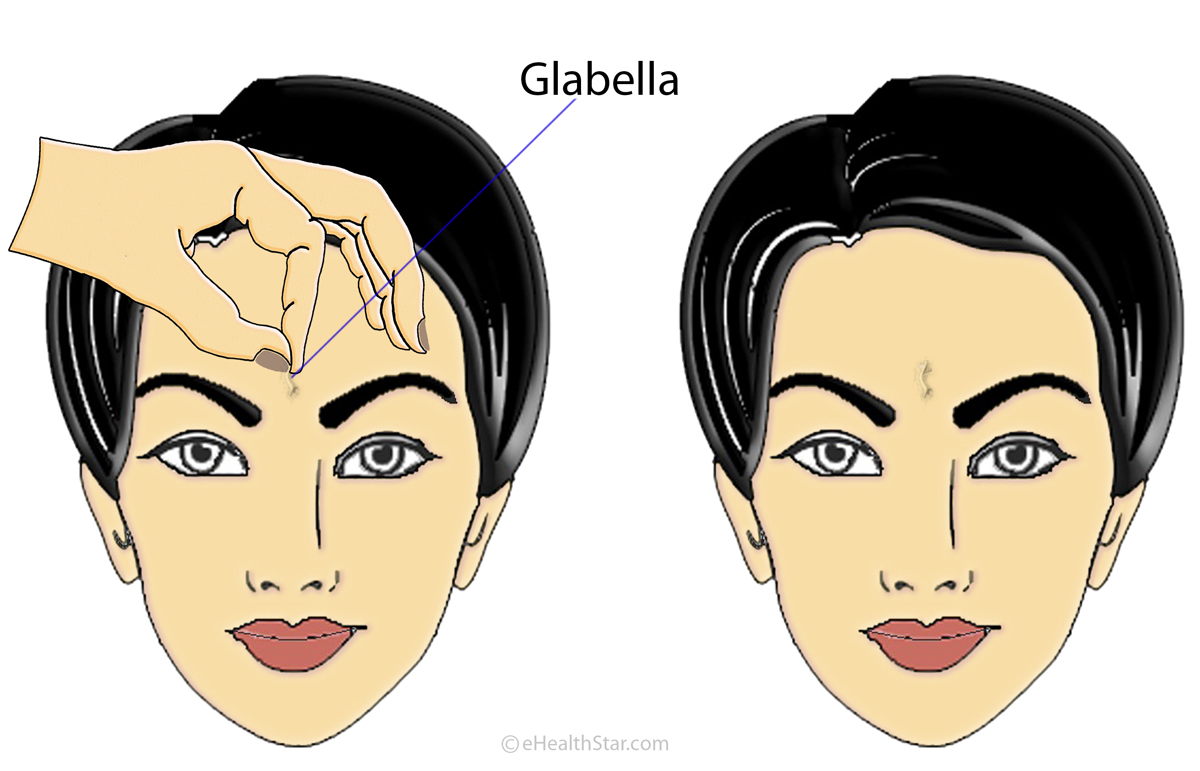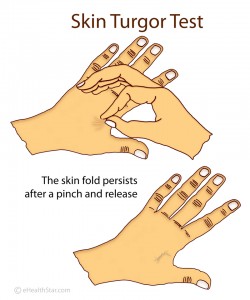What is skin turgor?
Skin turgor [from Latin turgor = the normal state of fullness] refers to skin tension or elasticity, because of which the skin recoils after you pinch and release it [22]. A doctor or a nurse uses the skin turgor test during a physical examination to check for eventual dehydration.
What is skin mobility?
Skin mobility is the ability of the skin to be pulled from its original position. The skin that has increased mobility usually, but not always, has decreased turgor and vice versa.
Skin Turgor Assessment
A doctor or a nurse pinches a patient’s skin with the thumb and index finger and releases it and then measures the time needed for the skin to recoil completely.
Picture 1. Skin turgor assessment on the forehead (at glabella)
Picture 2. Skin turgor assessment on the back of the hand
CHART 1. Locations for Skin Turgor Test |
|
| SITE – FROM MOST TO LEAST RELIABLE | COMMENT |
| Glabella — the most prominent part of the forehead between the eyebrows (Picture 1) [6] | The least affected by age-related skin wrinkling |
| Upper chest: over the sternum or below the clavicle | |
| Forearm (outer side; see Video 1 below), thigh (inner side) [14] or calf (the back side) [3] | Least discomfort in a patient |
| Abdomen, near the umbilicus [12] | In infants and small children |
| Back of the hand between the thumb and index finger (Picture 2) | Less reliable, affected by age-related wrinkling, but convenient for a self-test |
| UNRELIABLE SITES | |
| Neck | Often, redundant, saggy skin [8] |
| Face, back, buttocks | Skin turgor decreased only in severe dehydration |
| Finger knuckles | Poor skin turgor despite good hydration |
Video 1: Description of the skin turgor test on the forearm
Explanation of the Results
- The skin that, after being pinched and released, recoils immediately suggests good hydration.
- A skin fold persisting for <2 seconds suggests mild dehydration.
- A skin fold persisting for 2-10 seconds speaks for moderate dehydration.
- A skin fold persisting for several seconds or even minutes speaks for severe dehydration.
- References: 1,3
A Measure of the Skin Turgor in Medical Documentation Charts
In different hospitals, doctors and nurses may use different terms to describe skin turgor “types:”
- WNL — Within Normal Limits (there is no actual “normal range,” so only immediate recoil is normal)
- Normal vs. prolonged (delayed)
- Good vs. poor (reduced, decreased)
- Elastic vs. non-elastic
- Brisk (resilient) vs. sluggish
- Tenting (doughy), if prolonged for several seconds or minutes
An example of a documented skin turgor test: “Skin recoil 3 seconds at clavicle.”
No more detailed classification or rating of skin turgor values exists.
Normal Skin Turgor
Skin turgor is considered normal when the skin after being pinched and released recoils almost instantly (in less than 0.5 seconds). Note, that immediate skin recoil does not always mean good hydration: obese people, those with a condition with a thick skin called scleroderma or other conditions can have normal skin turgor but can be dehydrated (see Chart 3).
Poor Skin Turgor
Skin turgor is considered poor when the skin recoil is delayed for any amount of time, even if only for a half of a second. Note, that decreased skin turgor does not always mean dehydration: older people and others with wrinkled skin have poor skin turgor but can be well hydrated (see Chart 2).
Mechanism
Normal skin turgor (fullness and elasticity) is maintained by the presence of water and elastic fibers in the skin. Skin elasticity can decrease either due to whole body dehydration or due to “isolated” skin dehydration (without whole body dehydration), commonly observed in elderly.
Chart 2. Causes of POOR (DECREASED, PROLONGED) Skin Turgor |
|
| CAUSES | COMMENTS |
| Dehydration | Most common cause |
| Wrinkled skin caused by age or smoking [20] | |
| Quick loss of weight [20] or decreased abdominal volume in women after delivery | Redundant skin on the abdominal wall |
| Malnutrition: deficiency of vitamin A, C or E, or selenium [4] | Common in chronic alcoholism, prolonged starvation, anorexia nervosa |
| End-stage kidney failure in individuals on hemodialysis or peritoneal dialysis | Dry, rough skin or xerosis |
| Cutis laxa with skin hanging in folds; loose joints | Inherited or acquired connective tissue disease |
Chart 3. Causes of INCREASED Skin Turgor (Decreased Skin Mobility) |
|
| CAUSES OF DECREASED SKIN MOBILITY and INCREASED TURGOR | COMMENTS |
| ALL OVER (GENERALIZED) | |
| Obesity [21] | Thick skin due to increased skin fat |
| Severe kidney failure resulting in generalized edema (anasarca) | Water retention |
| Severe systemic allergic reaction (anaphylaxis) | Escape of fluid from the vessels |
| Septic shock | |
| Systemic sclerosis (scleroderma), Sjögren’s syndrome, Ehlers-Danlos syndrome | Overgrowth of the fibrous connective tissue in the skin |
| FACE and UPPER BODY | |
| Treatment with steroids | |
| LOWER LEGS — SYMMETRICALLY | |
| Pitting edema due to prolonged standing or sitting, pregnancy, menstruation, chronic heart failure, kidney failure, nephrotic syndrome, water intoxication with hyponatremia [11,18] | When you press the skin over the shinbone with the thumb it remains depressed for few seconds |
| Nonpitting edema due to hypothyroidism or myxedema | Pretibial edema |
| LOWER LEGS — ASYMMETRICALLY | |
| Varices (chronic venous insufficiency), deep vein thrombosis, obstruction of the lymph flow in elephantiasis, lymphoma, tumors in pelvic cavity | |
| ABDOMEN (ASCITES) in liver cirrhosis | Abdominal distension |
Dehydration and Skin Turgor
Poor skin turgor is a relatively late sign of dehydration and can be observed in moderate and severe dehydration, that is after a loss of more than 3% of body weight [1].
Causes, Symptoms and Signs of Dehydration
A doctor can make a diagnosis of dehydration from a combination of known or suspected causes, symptoms, signs and skin turgor test:
- Causes: insufficient drinking, excessive sweating, hyperventilation, diarrhea, vomiting, excessive urination or polyuria, for example, in diabetes mellitus
- Symptoms: thirst, less urination, dark urine, fatigue, loss of body weight
- Signs: dry mouth, poor skin turgor, sudden loss of body weight
Metabolic Disorders and Skin Turgor
Metabolic disorders by themselves do not affect skin turgor, but certain metabolic disorders are associated with dehydration and hence with poor turgor:
- Hypernatremia [13,14]
- Hyperkalemia with hyponatremia in adrenal insufficiency (hypoaldosteronism) [7]
- Hyperglycemia in untreated diabetes mellitus
Chart 4. Differential Diagnosis of Skin Turgor |
|||
| CONDITION WITH POOR SKIN TURGOR | SKIN SIGNS | SYMPTOMS and SIGNS | CIRCUMSTANCES |
| Severe dehydration | Pale, cool, dry skin | Excessive sweating, diarrhea, vomiting | |
| Heat exhaustion | Pale, cool, moist skin | Body temperature 98.6-104 °F (37-40 °C) | Hot weather, insufficient drinking |
| Heat stroke | Flushed, warm, dry skin | Body temperature > 104 °F (40 °C), severe headache | Hot weather, insufficient drinking |
| Hypovolemic shock | Pale, cool, moist skin | Low blood pressure (late sign) | Severe bleeding |
Skin Turgor in Infants and Toddlers
- Usually checked on the abdomen [2,16]
- A common cause of poor skin turgor in small children is dehydration caused by diarrhea.
- Other signs of severe dehydration in infants: dry mouth mucosa, sunken fontanels and eyes, decreased body weight, prolonged or minimal capillary refill after pressing upon a nail [1,2]
Skin Turgor in Elderly
- Many older adults have permanently wrinkled skin due to reduced skin turgor because of skin dehydration, which is NOT the same as overall body dehydration. An older person with reduced skin turgor can be well hydrated, dehydrated or even overhydrated, so the skin turgor test in elderly may not be a reliable test for dehydration.
- In elderly, skin turgor can be optimally assessed at sites that are least affected by skin wrinkling: over the sternum, below the clavicle, in the forehead between the eyebrows [9] or on the inner thighs [14]. Hands and arms are not a good site to check for skin turgor in elderly [15].
- Poor skin turgor is a risk factor for pressure ulcers in bedridden elderly individuals [10].
- References
- Emedicine (Physical examination findings in pediatric dehydration)
- Jamanetwork.com (Skin turgor in infants)
- Nejm.org (Severe dehydration)
- Nyu.edu (Antioxidants–vitamin A, C, E,selenium–and wrinkled skin)
- Clevelandclinic.org (Skin related complications of diabetes)
- Askdefine.com (Glabella)
- Oxfordjournals (Hypoaldosteronism, hyponatremia, hyperkalemia and dehydration)
- Passeidireto.com (Evaluation)
- Nursinghome.org (Geriatric patients)
- Docs.google.com (Pressure ulcers)
- Emedicine (Pediatric nephrotic syndrome)
- Fluid and Electrolyte Balance, y.2012 (Skin turgor in children)
- Emedicine (Hypernatremia)
- PubMed (Hypernatremia in elderly)
- Nursing Diagnosis Handbook, An Evidence-Based Guide to Planning Care, 10th edition, y. 2013, p.364 (Geriatric skin turgor assessment)
- Pediatric Nursing: Caring for Children and Their Families, 3rd edition, y. 2012, p.448 (The procedure in children)
- Portable Signs and Symptoms, by Lippincott Williams & Wilkins, y. 2008 (Systemic sclerosis)
- Adult-Gerontology and Family Nurse Practitioner Certification Examination, p. 203 (Edema)
- MedlinePlus (Gas gangrene)
- WebMD (Causes of wrinkled skin)
- Patient.info (Obesity)
- Adam.com (Definition)




Thanks for the long informations about turgor. In my case it’s actually almost everywhere in my body but the head and the chin are the most affected. Today I was surprises to see how long it took for my chin to recovered when I pinched it. It’s amost like a you would a bubble gun into shape. Please can someone help me. I saw a doctor and she has nothing to day but some people are like that.
Thanks for the long informations about turgor. In my case it’s actually almost everywhere in my body but the head and the chin is the most affected. Today I ws surprises to see his long it rap for my chin to recovered when I pinched it. It’s a most like a you would more a bubble gun into shape. Please can someone help me. I saw a doctor and she has nothing at but some people are like that.
Good article, especially with pulling the info all into one place since different terms and assessment methods are used by different nurses and other medical personel, and in different facilities.
Thank you this article was very helpful to reinforce information received in the past a while ago. This article has more details about it. Thank you for taking the time to do this.
this was a pretty good article